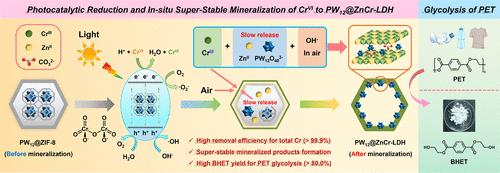CrVI光催化还原原位超稳定矿化制备PW12@ZnCr-LDH及其在PET糖酵解中的应用
IF 3.9
3区 工程技术
Q2 ENGINEERING, CHEMICAL
引用次数: 0
摘要
去除有毒、高可溶性、不可生物降解的六价铬(CrVI)一直是废水净化技术面临的主要挑战。本文采用原位超稳定矿化策略完全去除水体系统中的Cr(包括CrVI和CrIII)。详细的准原位x射线衍射(XRD)和透射电镜(TEM)结果表明,在可见光照射下,通过PW12@ZIF-8 (PW12 = H3PW12O40·nH2O), CrVI可以原位超稳定矿化为PW12@ZnCr-LDH (Ksp≈10-60)。总Cr在24 h内的去除率可达99.9%,PW12@ZIF-8对CrVI的最大矿化能力可达224.6 mg g-1,超过了目前报道的大多数Cr矿化剂。根据x射线吸收精细结构(XAFS)、电子自旋共振(ESR)等结果,提出了去除机理:在可见光照射下,PW12@ZIF-8生成的中间体·O2 -和·OH可将CrVI还原为CrIII,而在PW12@ZIF-8中缓慢释放的Zn2+存在下,CrIII可原位生成PW12@ZnCr-LDH。矿化产物PW12@ZnCr-LDH用于聚对苯二甲酸乙二醇酯(PET)糖醇解,其收率高达83.12%,对各种消费后PET具有良好的适用性。本研究为含铬废水的处理和再生铬资源的利用提供了一条新的途径。本文章由计算机程序翻译,如有差异,请以英文原文为准。

Photocatalytic Reduction and In Situ Superstable Mineralization of CrVI to PW12@ZnCr-LDH and Its Application for Efficient PET Glycolysis
The removal of toxic, highly soluble, and nonbiodegradable hexavalent chromium (CrVI) has been a major challenge for wastewater purification technologies. Herein, the in situ superstable mineralization strategy was applied for the complete removal of Cr (including CrVI and CrIII) in aquatic systems. Detailed quasi in situ X-ray diffraction (XRD) and transmission electron microscopy (TEM) revealed that under visible-light irradiation, CrVI can be in situ superstably mineralized in the form of PW12@ZnCr-LDH (Ksp ≈ 10–60) by using PW12@ZIF-8 (PW12 = H3PW12O40·nH2O). The removal efficiencies of total Cr can reach > 99.9% in 24 h, and the maximum mineralization capacities of PW12@ZIF-8 toward CrVI can achieve 224.6 mg g–1, surpassing most Cr mineralizers reported so far. On the basis of the results of X-ray absorption fine structure (XAFS), electron spin resonance (ESR), etc., the removal mechanism was proposed as follows: the CrVI can be reduced to CrIII by the intermediate ·O2– and ·OH generated by PW12@ZIF-8 under visible-light irradiation, and the CrIII in the presence of slowly released Zn2+ from PW12@ZIF-8, leading to in situ formation of PW12@ZnCr-LDH. Furthermore, the mineralized product PW12@ZnCr-LDH was used for polyethylene terephthalate (PET) glycolysis, which demonstrated a high BHET yield of 83.12% and excellent applicability to various postconsumer PET. This work provides a new pathway for the CrVI-containing wastewater treatment and utilization of the recycled Cr resource.
求助全文
通过发布文献求助,成功后即可免费获取论文全文。
去求助
来源期刊

Industrial & Engineering Chemistry Research
工程技术-工程:化工
CiteScore
7.40
自引率
7.10%
发文量
1467
审稿时长
2.8 months
期刊介绍:
ndustrial & Engineering Chemistry, with variations in title and format, has been published since 1909 by the American Chemical Society. Industrial & Engineering Chemistry Research is a weekly publication that reports industrial and academic research in the broad fields of applied chemistry and chemical engineering with special focus on fundamentals, processes, and products.
 求助内容:
求助内容: 应助结果提醒方式:
应助结果提醒方式:


